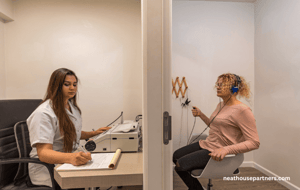Health, safety and sitting versus standing in the office
Standing desks are a great way to prevent sedentary behaviour at work. But while all day sitting is poor for health, so is standing, too.
James Rowland
Commercial Director James leads Account Management, Sales and Marketing at Neathouse Partners.Date
07 May 2024Updated
12 June 2024
Table of contents
Thursday 25 April 2024 marks the ‘On Your Feet Britain’ campaign, in association with Yo-Yo DESK®. It’s a day that focuses on getting office workers in Britain standing up more, and to unite against prolonged workplace sitting because of the negative health impact sedentary lifestyles can bring.
Workers’ challenges include #Move More and #SitLess – anyway they can. With this in mind, and with National Walking Month starting in May, it’s time to look at the health benefits of sitting and standing in the office, and what employers need to know from a health and safety perspective.
Standing desks – the answer to sedentary sitting?
Standing desks are workstations that are designed for working while standing. They’re usually smaller than other sitting desk styles, because they can be adjusted to various heights depending on user needs. Standing desks come in various configurations, and having a standing desk can be better for posture – reducing the sedentary behaviour associated with prolonged periods of sitting.
Standing desks can have many health benefits, including increased energy, improved circulation, and a reduced risk of health conditions such as cardiovascular disease, stroke and obesity. By having standing desks, workers also have flexibility across the working day, allowing them to alternate between sitting and standing, depending on how they’re feeling.
The benefits of standing in the workplace
Here are some of the health advantages that standing desks can offer workers:
Better posture
Standing desks encourage a person to stand upright and straight, which can help to better align the spine more naturally (compared to sitting in a more hunched position). Better posture relieves pressure and strain on the shoulders, neck and back, which helps reduce the risk of musculoskeletal problems.
Improved circulation
Sitting for long periods restricts blood flow to the legs and feet, whereas standing while working encourages a person to shift their weight during the day.
Increased concentration levels and well-being
Using a standing desk can increase levels of alertness, as it improves better blood flow to the brain, which can enhance cognitive function and concentration. Standing also encourages more movement, which releases endorphins.
Reduced risk of chronic diseases
Type 2 diabetes, types of cancer and cardiovascular disease are all chronic disease risks that have been linked to sedentary lifestyles. Standing desks can help to reduce the risk of developing these conditions.
The drawbacks of standing while working
Standing for long periods at work can however have its problems, including:
Foot problems
Standing for long periods can cause issues with the Achilles tendon, and can strain other ligaments and tendons in the feet. Workers with foot conditions may find using a standing desk uncomfortable.
Repetitive strain injuries
Movements associated with standing, such as leaning or shifting weight, can cause strain injuries if body weight isn’t shifted from time to time.
Fatigue and muscle pain
Standing for long periods of time can lead to aches and discomfort in the lower back, neck, legs and feet, as it places increased strain on the lower body. Standing for prolonged periods can be physically demanding, leading to poorer levels of focus and concentration.
Risk of varicose veins
Standing for long periods can cause varicose veins, because of the extra pressure placed on the veins themselves. Standing desks may exacerbate this risk, especially if you don’t shift your weight frequently. This can cause swelling in the legs and feet.
Sitting or standing: which is best at work?
The debate between sitting and standing at work has gained considerable interest since the world came out of the Covid-19 pandemic, especially as more people now work from home. Sitting at a desk to work clearly comes with many benefits, such as comfort and convenience, especially when working for longer hours. Ergonomic chairs that are designed to support the body and reduce strain can help to promote better posture for those who need to sit at a desk for work.
On the other hand, supporters of standing claim it helps to combat the detrimental effects of prolonged sitting, such as the increased risk of obesity and cardiovascular disease. Because of increased blood flow and the engagement of core muscles, standing can also boost productivity.
Ultimately, the best choice for employers is to give workers the tools they need to be able to alternate between the two. Moderation and personal preference are important, and if workers can achieve a balance between sitting and standing, alongside regular breaks for stretching or walking, this can help to achieve better physical and mental health. The best approach can also vary depending on individual needs, job requirements and overall lifestyle factors.
Health and safety regulations and sitting
According to the Workplace (Health and Safety) Regulations 1992, employers must have adequate seating in place for employees who need to carry out their job responsibilities while seated. If tasks cannot be sufficiently performed in a seated position, suitable alternatives should be made available.
Employers must also ensure that employees have access to appropriate rest breaks to help them take regular movement throughout the day and to prevent prolonged periods of sitting.
It’s the employer’s duty to consider the nature of the tasks being performed by their workers, and to provide suitable working conditions for the roles being conducted.
For desk-based roles, employers must provide comfortable and ergonomic seating and other equipment to minimise the risk of injuries. Employers who don’t follow these regulations could be subjected to a Health and Safety Executive (HSE) investigation, fines or even prosecution (in serious cases). Non-compliance with H&S laws can lead to civil claims brought against the employer by employees and significant compensation payments for those affected by injury.
Carrying out a display screen equipment (DSE) workstation assessment will help you to protect your employees from ill health and ensure their workstation is designed correctly and fit for purpose.
Staying active during the workday
Here are some top tips employers can give workers to help them stay active at work. These could be written into a handbook or company policy to ensure they are taken seriously.
1. Take regular breaks
Encourage staff to take short breaks every hour to stretch muscles, stand up or walk around.
2. Take shorter meetings (stand-ups)
Promote meetings that take the form of shorter standing discussions (known as stand-ups).
3. Introduce standing desks
Standing desks help staff to alternate between sitting and standing, promoting better posture and encouraging movement across the working day.
4. Encourage at-desk exercises
Give employees information on exercises they can do at their desks to improve circulation and boost focus such as ankle circles, chair squats, arm and leg stretches. These are discreet exercises that can help prevent muscle stiffness.
5. Support healthy commuting
Encourage staff to ride a bike with cycle-to-work schemes, take public transport or walk to work where possible. You can also support taking the stairs rather than the lift.
6. Allow standing or walking around while taking calls
Enable staff to walk around the office while taking calls to support movement.
8. Check ergonomics
Ensure staff workstations are set up ergonomically.
We can ensure health and safety compliance
Employers have a duty to keep workers safe and healthy, which includes having access to suitable seating when needed, and encouraging rest breaks and activity throughout the day.
If your company needs help with understanding your HR and Health & Safety responsibilities, please contact our team of professionals at Neathouse Partners. We can ensure compliance with health and safety legislation. Call us on 0333 041 1094 today, or use our contact form.
Related blog posts

How to prevent eye strain at work

Guide to supporting and accommodating employees with chronic migraines
Have questions?
Get in touch today
Contact us, and our team will get back to you within 24 hours. We value your questions and are committed to getting them answered quickly.


Hello! I am Nicky
Just fill in the form below with your details, and I will arrange for a member of our team to give you a call.
By clicking, you agree to our Privacy Policy






